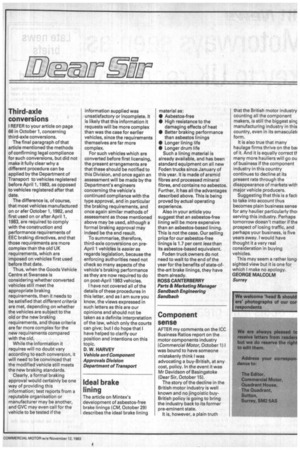Third-axle conversions
Page 25

If you've noticed an error in this article please click here to report it so we can fix it.
I REFER to your article on page 66 in October 1, concerning third-axle conversions.
The final paragraph of that article mentioned the methods of confirming legal compliance for such conversions, but did not make it fully clear why a different procedure can be applied by the Department of Transport to vehicles registered before April 1.1983, as opposed to vehicles registered after that date.
The difference is, of course, that most vehicles manufactured on or afer October 1, 1982, and first used on or after April 1, 1983, are required to comply with the construction and performance requirements of EEC braking directives, and that those requirements are more complex than the old UK requirements, which are imposed on vehicles first used before that date.
Thus, when the Goods Vehicle Centre at Swansea is considering whether converted vehicles still meet the appropriate braking requirements, then it needs to be satisfied that different criteria are met, depending on whether the vehicles are subject to the old or the new braking requirements, and those criteria are far more complex for the new requirements compared with the old.
While the information it requires will no doubt vary according to each conversion, it will need to be convinced that the modified vehicle still meets the new braking standards.
Clearly, a formal braking approval would certainly be one way of providing this information; test reports from a reputable organisation or manufacturer may be another, and GVC may even call for the vehicle to be tested if the information supplied was unsatisfactory or incomplete. It is likely that this information it requests will be more complex than was the case for earlier vehicles, since the requirements themselves are far more complex.
For such vehicles which are converted before first licensing, the present arrangements are that these should be notified to this Division, and once again an assessment will be made by the Department's engineers concerning the vehicle's continued compliance with the type approval, and in particular the braking requirements, and once again similar methods of assessment as those mentioned above may be used, although a formal braking approval may indeed be the end result.
To summarise, therefore, third-axle conversions on preApril 1 vehicles is easier as regards legislation, because the enforcing authorities need not check so many aspects of the vehicle's braking performance as they are now required to do on post-April 1983 vehicles.
I have not covered all of the details of these procedures in this letter, and as I am sure you know, the views expressed in such letters as this are our opinions and should not be taken as a definite interpretation of the law, which only the courts can give; but I do hope that I have helped to clarify our position and intentions on this topic.
D. W. HARVEY Vehicle and Component Approvals Division Department of Transport
Ideal brake lining
The article on Mintex's development of asbestos-free brake linings (CM, October 29) describes the ideal brake lining material as: • Asbestos-free • High resistance to the damaging effects of heat • Better braking performance than asbestos linings • Longer lining life • Longer drum life Such a lining material is already available, and has been standard equipment on all new Paden trucks since January of this year. It is made of aramid fibres and processed mineral fibres, and contains no asbestos. Further, it has all the advantages described above. This is being proved by actual operating experience.
Also in your article you suggest that an asbestos-free lining will be more expensive than an asbestos-based lining. This is not the case. Our selling price for our asbestos-free linings is 1.7 per cent /essthan its asbestos-based equivalent.
Foden truck owners do not need to wait to the end of the year for the benefits of state-ofthe-art brake linings, they have them already.
ROSS CANTERBERRY Parts & Marketing Manager Sandbach Engineering Sandbach
Component sense
AFTER my comments on the ICC Business Ratios report on the motor components industry (Commercial Motor, October 1) I was bound to have someone mistakenly think I was advocating a buy-British, at any cost, policy. In the event it was Mr Davidson of Basingstoke (Dear Sir, October 15).
The story of the decline in the British motor industry is well known and no jingoistic buyBritish policy is going to bring the industry back to its former pre-eminent state.
It is, however, a plain truth that the British motor industry counting all the component makers, is still the biggest sinc manufacturing industry in this country, even in its emasculat( form.
It is also true that many haulage firms thrive on the ba( of it. And it is equally correct th many more hauliers will go ou of business if the component industry in this country continues to decline at its present rate through the disappearance of markets with major vehicle producers.
Suggesting that this is a fact, to take into account thus becomes plain business sense for any haulier particularly tho! serving this industry. Perhaps tomorrow doesn't matter if the prospect of losing traffic, and perhaps your business, is five years away. I would have thought it a very real consideration in buying vehicles.
This may seem a rather long. sighted view but it is one for which I make no apology. GEORGE MALCOLM Surrey








































































































































































